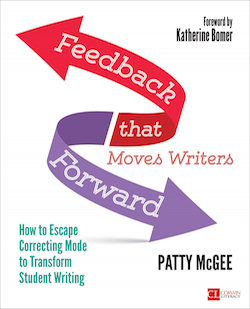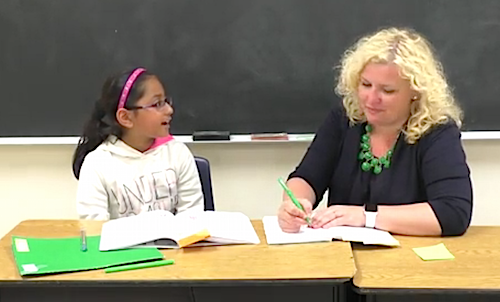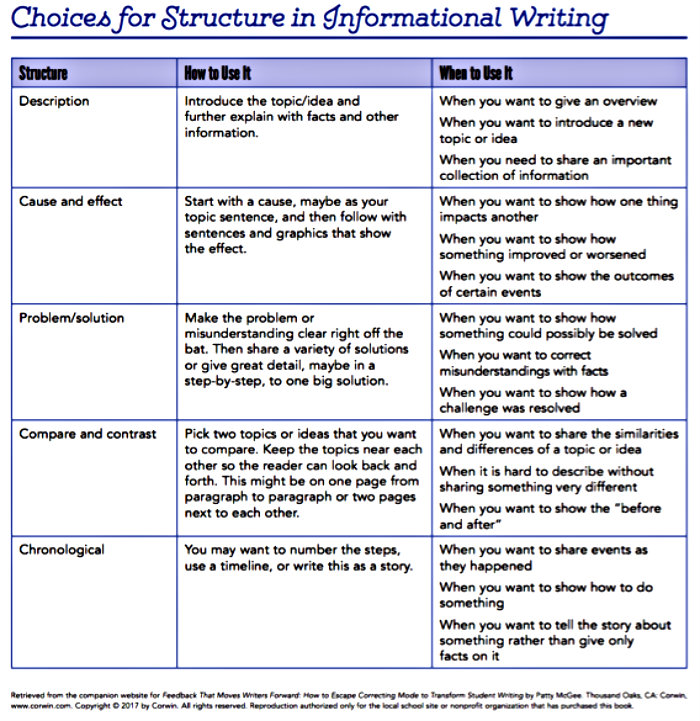Put Yourself in the Shoes of a Middle Grades Writer
 By Patty McGee
By Patty McGee
I write this article from the perspective of both an educator and the parent of a middle school student. Perhaps some of you are nodding in understanding, speckled with a little empathy, about the ins and outs of working and living with middle graders, including that feeling of joy that comes with this unique, blossoming age.
Right before our eyes we see:
► People who are unearthing their own, original identity. This is a time of life when they are creating distance with their parents (that’s the part that feels most challenging for me personally) in order to uncover who they are as people, their place in this world, how they relate to their peers, and their own self-sufficiency. Maybe you are noticing the role that writing plays in this.
► Writers for whom writing has become an act of bravery. In this time of life, where their peers’ opinions mean virtually everything, taking what is inside their head and heart and putting it on paper takes courage. They each know that whatever makes it to the paper will be seen, and judged, by those around them.
Because writers of this age are so extraordinary, we are called to adjust our teaching to truly suit our learners. This requires us to avoid sorting them into groups of “the best writers” “the weakest writers,” “creative but messy writers,” and “need-major-grammar-work writers.” Instead, we need to enter into a conversation with each one and ask ourselves: what does this writer need from me, in regard to this piece, right now?
Working with adolescent writers requires three essentials from us: presence, empathy, and choice.
1. Presence
Although conferences are quick conversations with writers, our first move is to be completely present with that young author. To be present is not easy in a class of many children and plenty of distractions, I realize. Yet we can quickly train ourselves to do this – it’s mostly an adjustment of thinking at that moment.
Simply put, being present means that in my mind I say to myself that I am prepared to give this one writer a bit of feedback that they are ready for. I am looking at this writer today, at 10:29 on a Tuesday, at a bit of the writing in whatever phase of the process he is currently in, and asking questions to find out what will be most useful for this writer.
Here are a few of my go-to conversation starters (I rarely ask them all):
What would you like my feedback on?
What has been tricky or challenging for you?
What message are you looking to send in this piece?
Who is your audience?
What have you tried already?
The gift of our presence is precious to writers of any age. The writer feels heard, and in that, their identity and voice is acknowledged and strengthened bit by bit. In this video clip below, notice how Tia assumes my presence by already coming to the conference with something she would like feedback on. By being present, I work to give her feedback on just what she is asking, knowing that, as Don Graves reminded us, we are teaching writers first and foremost.
2. Empathy
Being truly present in a conversation with a writer is the first step in helping that writer make brave choices. The next step is to virtually walk in that writer’s shoes. In other words, channel empathy. Here is my process:
- Once a writer shows me what s/he needs, I pause.
- I imagine that I am this writer, with this set of skills, passions, wants, readiness, etc.
- I ask, “What would be my natural next step if I were this writer?”
Referring back to the video of Tia, when she shared that she wanted to introduce a character and all of the ways she knows how, I thought to myself, “If I were in her shoes right now, what would I do next?” That became my strategy.
Empathetic teaching reminds us of the place middle graders are in their lives right now and grounds us in the needs and readiness of these budding writers.
3. Choice
Both presence and empathy connect us to writers who are seeking autonomy and refining their own voice. What I consider the pinnacle for supporting our middle grades writers is choice.
A moment on my soapbox: “Choice-less” writing approaches are wrecking kids with prompts, rules, and mandatory structures. Ten years of that and most students don’t find the way to their own voice and originality. The middle years are especially pivotal to build in choices for writers. Seventh grader Sophia lamented to me,
“I love to write. I just wish I had teachers who let me take risks and make some of my own choices. But in writing, you have to read the teacher’s mind. I find that a lot of kids don’t even try. The one thing we have been given since I was in first grade was the same structure over and over again. One time I tried to add my own ideas and I got a failing grade.”
For the sake of all writers, writing instruction must evolve away from a hyper-focus of rules and single-minded structures, and instead make it truly okay to be original in one’s writing. What happens as a result? The writing identity and originality flourish, and these “rising tides” lift all boats, because writing “skills” and student performance on standardized tests ascend as well.

To be clear, suggesting choices is not a “free for all” kind of approach to feedback. On the contrary, it allows for the agency of the writer to emerge while also providing space for teacher guidance.
Combining the three essentials
Imagine that you are working with a writer who is composing a piece of informational writing on dolphins. Here’s how the conversation might go:
Be present: She has expressed that she wants to share how dolphins are treated by humans.
Be empathetic: This writer has shown that she has lots of ideas in her notebook and a bigger message she is trying to send. I think, what would be my natural next step? Perhaps trying out some different informational text structures. This chart lists some ideas:
Offer Choice: I might say, “I’d like to show you two structures that you may want to try out in your writing: cause and effect and description. Here is how to use it (I turn to the chart for some help from column two) and when to use it (again, I turn to the chart for some more wording in column three). I may even show an example.
Looking for other choice-supportive charts? Click here to find resources for offering choice in elaboration for narrative, informational, and opinion/argument writing as well as offering choice in grammar.
Making the essential connection
Middle graders are unique, often unpredictable writers who are thirsty for refining their own personal voice, and so our approach to feedback can take on the form of present, empathetic, choice-filled response. This starts with the writer’s heart – the place where all strong, original writing is born – and connects us to these beautiful, quirky, precocious learners.
________________________






































Outstanding. Thank you, Patty. You share my passion for developing middle school writers. Thank you for the templates as well. That’s where I need the help.
Like you, I have found a short one-on-one conference with a student is so productive. Two effective questions I have used are “What section of your piece do you want me to read?” and “What are your next steps?” which may very well lead to the same outcomes as some of your questions. Your focus on empathy is so insightful. Sometimes I forget what my students are experiencing. Thank you for a very helpful article.